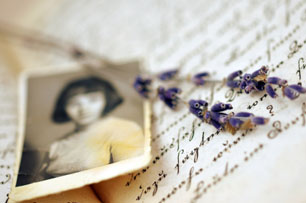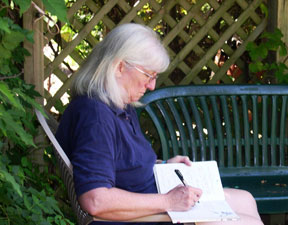ince the time when humans first scratched out symbols and figures recording a successful hunt or an important journey on the walls of caves and the sides of mountains, writing has been personal. For women, through the ages, writing in a journal was a means to have a voice when silenced; a means to share their lives when no one was there; and a means to re-create themselves when they were stuck in a mold.
Journal Writing Across the Ages
Evidence of the first journals written in text date back to the second century. While physical evidence of women as diarists or journalists does not appear until around the ninth century, it is not difficult to believe that there were literate women who placed their dreams, fears, hopes, and aspirations onto parchment in earlier days.
The word journal comes from the French word, le jour, meaning day. Journals are synonymous with diaries, coming from the Latin for day, which is deis. Journals and diaries kept the daily accounts of everything from travel, business, and social events to personal thoughts, reflections, and ideas.
Japan gives us the oldest extant diaries written by a woman. Sei Shōnagon, who attended the Empress Teishi, wrote Pillow Book (Makura No Soshi), consisting of over 300 sections during the tenth century. While some sections were lists of various types, others included stories, observances, and commentary on life. Shōnagon may have been an attendant to the empress, but she was also a literate woman who found great pleasure in recording her personal thoughts on any number of subjects.
Shōnagon’s love of writing and reading are evident in these lines from Pillow Book, “If letters did not exist, what dark depressions would come over one! When one has been worrying about something and wants to tell a certain person about it, what a relief it is to put it all down in a letter! Still greater is one’s joy when a reply arrives. At that moment a letter really seems like an elixir of life.”
Journals gained popularity during the Middle Ages. Women such as Hildegard von Bingen (twelfth century) wrote extensively. Hildegard’s writings not only give us insight into her spirituality, but also record the healing powers of plants, animals, and minerals. Her journals are still used as a primary source by researchers.
Jumping forward in time to the book that informed my passion for journal writing, The Diary of Anne Frank, is one of twentieth century’s most well-known texts. A personal and poignant account of coming of age during the horrors of the Holocaust, the diary was a friend to whom the young girl could confide during a time when there seemed to be few friends around. Anne named her diary Kitty.
Today, journaling and diaries have morphed from special books hidden in secret spots to online exposés found on blogs and social networks. While the manner in which we record our reflections, comments, dreams, and even lists has changed, the value of journaling has lost none of its appeal.
Why Women Keep Journals
South African novelist and Nobel Prize winner Nadine Godimer wrote, “Writing is making sense of life. You work your whole life, and perhaps you’ve made sense of one small area.” Making sense of our lives is one of the many reasons women keep journals. Something quite magical occurs when we place our thoughts on paper or into a computer page daily.
Women keep journals as a means to record the events of their lives. The births, deaths, and friendships, no matter how trivial, give a personal, sometimes heartbreaking, account of the love, betrayal, healing, illumination, and the epiphanies that make us whom we are.
Women use journals as a repository for their favorite quotes and poems. The ability of another’s words to inspire or affirm is why keeping a journal is important to women. The writings of others touch our hearts and souls, helping us to feel deeply, even when everything around us attempts to negate our feelings.
Additionally, women keep journals as a legacy to others, especially other women. Often, this may be an unconscious decision; but ultimately, it is the unspoken hope that someone else will find value in what we are saying that keeps us writing.
Anne Morrow Lindbergh wrote, “I believe that what a woman resents is not so much giving herself in pieces as giving herself purposelessly.” Journal writing gives women purpose.

“Those that journal will attest to the fact that life’s answers often find their way within the pages of our journals and diaries.”
Certainly, historians have great respect in journals and diaries as primary sources of life during a particular period. Where would filmmaker Ken Burns be without the journals of those who experienced firsthand the events portrayed in his documentaries?
Finally, women write journals as a catalyst for healing. Author and nurse Diana Raab used journaling as a means to make sense and find healing from a diagnosis of cancer. She then took her writing one step further, creating a book, Healing with Words: A Writer's Cancer Journey, which others can use to learn about the process she lived through and find inspiration for their own personal journey, as well as record their own thoughts prompted by Raab’s prose and poetry.
Perhaps, the human condition is the cause for not looking for answers to life’s toughest questions within ourselves. Yet, those that journal will attest to the fact that life’s answers often find their way within the pages of our journals and diaries. The stress that overwhelms us, that keeps us from seeing clearly, and that knocks us off balance alleviates when we write.
Whether writing about the stress caused by disease of the body or the disintegration of a relationship, whether recording words that lighten our load or inspire us to write in other genres, journaling helps us to find the center of our balance once more. Journaling does not cure us of anything; however, research proves that the troublesome situations in our lives are less overwhelming when we journal.
Enlightenment on the Written Page
According to Word and Phrase Origins by Robert Hendrickson, the word overwhelm “comes from the Middle English word whelven. This meant to capsize or turn over a vessel...so as to cover it with water, which lead to the modern meaning.”
More often than not, we write when we feel overwhelmed, when the waters of life threaten to drown us. Getting over the “whelm,” therefore, would mean being above water once more. To get there, it is necessary to find lessons tucked within our writing as well as the writing of others.
When searching for answers to feelings of inadequacy, feelings of ingratitude, or feelings of hopelessness, the writings of authors who have lived through difficult times bring illumination to the dark corners of our lives, helping us to see we are not alone. For instance, Anne Morrow Lindbergh in Gift from the Sea tells us, “I begin these pages for myself.” Here, journal writing was, she thought, personal and private. However, she goes on to say that in sharing her writing—the thoughts recorded in her journal—she came to realize that others had similar, if not identical, thoughts and feelings. Her “gift” was that she realized that she was not alone.
Finding connections to others of like-mind is only one example of the epiphanies experienced by those who read and write journals. Sometimes, a tiny phrase opens our eyes like, “Think of all the beauty still left around you and be happy.” (Anne Frank) Other times, it is an entire text that touches us. What mother does not find comic relief within the honest and profoundly personal writings of Anne Lamott’s, Operating Instructions: A Journal of My Son's First Year? The title alone is enough to cause us to smile and giggle.
Often, as is the case with journals and diaries that become part of historical record, the words we write for ourselves leave a legacy for coming generations. Writer Zora Neale Hurston is such an example. Hurston, known as a novelist and short story writer, kept diaries during trips to Florida’s Everglades and New Orleans that gave anthropology the first scientific records of African American folklore and voodoo by an African American. Understandably, her personal experiences, during the two years she researched, gave inspiration to her later stories.

“Finding connections to others of like-mind is only one example of epiphanies experienced by those who read and write journals.”
Healing with Words
When I interviewed author Diana Raab just after the release of her book, Healing with Words: A Writer's Cancer Journey, the first question I asked was, “What is your understanding of how journal writing helped in the healing process?”
She explained, “Regular expressive writing has been shown to elevate mood, decrease stress, and improve sleep, work efficiency, and how people deal with one another. Biologically, all of these factors can positively boost the body’s immune system.” She based this on the work of Dr. James Pennebaker, a pioneer in journal therapy.
Dr. Pennebaker and researchers from esteemed research institutions, such as the Dana-Faber Cancer Institute and Harvard Medical School, found that expressive writing (journaling) about specific illnesses, diseases, and conditions had positive physical, mental, and emotional results—some of which were unexpected. Researchers believe continued research is necessary to demonstrate the extent of efficacy that expressive writing has as a therapeutic technique.
Journaling has gained public recognition as a healing modality since 1960, when reflective writing first became a tool in psychotherapy through 1985 when Kathleen Adams founded the Center for Journal Therapy in which she taught and gave classes on journaling as a means of self-discovery. Today, numerous books on journal writing appear on bookstore shelves with titles, such as Writing Down the Bones by Natalie Goldberg and Writing as a Way of Healing by Louise DeSalvo. These books focus on ways to heal the spirit, thereby freeing the writer of stress, painful memories, and emotional baggage that prevent the writer from being healthy.
Other books on journal writing, such as Arc of the Arrow by Carolly Erickson and The Artist's Way by Julia Cameron, encourage writers and artists to rediscover their creativity through journal writing. Prompts within these books encourage the writer to look reflectively at their fears, limiting beliefs, and other forces that inhibit their creativity.
Journaling as a reflective tool has made its way into the classroom, as well. Teachers across the curriculum use reflective journals to enable students to grasp difficult concepts as well as relate those concepts to their own lives. Scholarly research shows that students who keep reflective journals become better students through the practice of thinking critically—evaluating what it is they are learning and deciding the value of that knowledge for themselves. In addition, the regular exercise of writing in a reflective journal develops students’ writing skills.
Students, who use reflective journals, write about their personal fears and anxieties, as well as their strengths within the subject matter. While it is not the purpose of keeping scholarly reflective journals, students who write in them regularly have less stress over their academics and life, which translates into healthier people.
Dr. Gail Ellison wrote about a Reflective Writing Course offered to medical students in a report to the San Francisco Medical Society. She observed that “the stress-reducing and community-building aspects of Reflective Writing receive high rankings in student evaluations of the course. The busy students maintain remarkable attendance—typically voting to continue to meet during finals, even though grades have been submitted—not only to write and discuss fears and challenges, death and dying, reservations and commitment, and other topics that determine their future professionalism, but also to drop their shoulders and laugh and cry, together.”

“What we write on pages of paper or across a computer screen is our personal legacy to others.”
(Photo of Linda Rhinehart Neas)
Memories, Ideas, Wisdom, Oh My!
How do journals become a personal reserve of ideas that a writer can pull from in their writing? The answer is simply by existing in the first place. As seen in the writings of Anne Lamott, Diana Raab, Anne Frank and a host of others, our journals are the fodder for further writing, waiting for harvest.
Within the pages of our journals are the people, places, and situations that have left a mark on our lives. We can develop a character based, for instance, on the psychopathic manager that drives us crazy at work or the lost love of our teen years that moved away before things got serious.
Our journals are also repositories for snips of ideas and gems of wisdom. Poems, quotes, passages from books or articles that touch us can all find a home within a journal. Then, when the time is best, when the writing has had time to ferment, we draw out the finest bits to share with the world.
Keeping journals of our memories, ideas, thoughts, or dreams takes time, but it is time well spent. For instance, I religiously kept a journal during a trip to the Cayman Islands. Later, what I wrote contributed details to a short story. I would not have had these details if, while traveling through the islands, I had not recorded what my senses picked up during my journey.
On another occasion, a journal I kept of poems, thoughts, and quotes for a year became a gift to a dear friend who had moved from the U.S. back to Spain. My friend and I spent hours talking about writing and sharing philosophies and thoughts. We both knew we would miss our times together when he left. This journal became a personal testament to friendship and the connections we make that last a lifetime.
Our Legacy
The journals, diaries, and memoirs we write are more than an indulgence, more than a healing tool, and much more than a writing exercise. What we write on pages of paper or across a computer screen is our personal legacy to others.
Recently, I found a journal of writing my mother kept. She had copied, in her perfect Palmer-method penmanship, poems that touched her. Poetry had always been a gift we shared, so finding her journal among her belongings gave me great joy. This was her legacy to me and to my daughters and their daughters. Since finding it, I have begun to evaluate what I write with a more critical eye, realizing that my personal reflections will someday inform my daughters and grandchildren of the woman their grandmother once was.
Of course, it is never too late to begin keeping a journal, to begin building our legacy. Many writers penned their first entries into their journals and diaries in their elder years. When one begins is not important, why and how are.
If we have a purpose for our writing, if we write regularly, then our journals will have focus. They will also provide us with the benefits of illumination, healing, honing of skills, and inspiration.
Journals are a link to the past and a reflection of the future. Writers leave a personal commentary that, when shared, finds universal connections across the barriers of time and space.
***
Linda M. Rhinehart Neas has written extensively in various venues, publishing and performing her work throughout New England. She has published two book of poems, Winter of the Soul (2008), and Gogo’s Dream: Discovering Swaziland (2010). Gogo’s Dream is a collection of poems dedicated to those who work to aid the peoples of Swaziland. All proceeds from the sale of Gogo’s Dream go directly to Possible Dreams International. Ms. Neas lives in an enchanted cottage with her Beloved. Visit her blog at Words from the Heart.
Linda is also an instructor for WOW! Women On Writing. She teaches Journaling for Holistic Wellness, a nine-week workshop that answers specific questions on the nine aspects of life found on the wellness wheel—physical, emotional, intellectual, cultural, economic, vocational, environmental, social and spiritual. Visit the Classroom Page for curriculum details and availability.
-----
Enjoyed this article? Check out these related articles and interviews on WOW!:
A Prescription for Positive Journaling
Journaling for Healing, Health, and Happiness
My Therapist, My Journal
Connect with Your Inner Writer: An Interview with Sheila Bender
Write to Heal, Write to Grow: An Interview with Carol Celeste
Interview with Natalie Goldberg
The Creative Life: An Interview with Julia Cameron